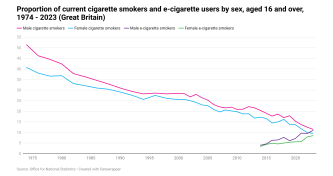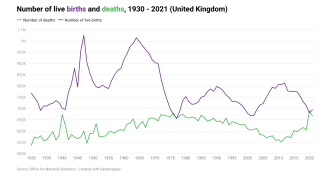Source:
- Office for National Statistics – Sickness absence in the UK labour market
Notes:
- The sickness absence rate is the percentage of working hours that are lost because of sickness absence.
- The sickness absence rate is calculated for all people in employment aged 16 and over.
- Quarterly Labour Force Survey (LFS) datasets were used to generate annual averages.
- The coronavirus (COVID-19) pandemic has affected the sickness absence data in many ways. Government policies around furloughing, homeworking, shielding, and social distancing have had an impact on estimates in 2020 and 2021. This has greater impact on the “Total days lost” and “Days lost per worker” measures, therefore the “Sickness absence rate” is the most appropriate measure to use to ensure comparability over time.
- The population totals used for the latest LFS estimates use projected growth rates from Real-Time Information (RTI) data for EU and non-EU populations based on 2021 patterns. The total population used for the LFS therefore does not take into account any changes in migration, birth rates, death rates, and so on, since June 2021, so levels estimates may be under-estimating or over-estimating the true values and should be used with caution. Estimates of rates will, however, be robust.
| Key dates | |
|---|---|
| 1996 | Employment Rights Act Required employers to provide a written statement of employment particulars to employees once they start work, including information on sick pay and procedures. |
| 1998 | Working Time Regulations Regulations which set a maximum of 48 hours for the working week on average. |
| 2000 | Part-Time Workers (Prevention of Less Favourable Treatment) Regulations Regulations protecting part-time workers from less favourable treatment than their full-time colleagues, including on pay and leave for sickness absence. |
| 2010 | Equality Act Required employers to make reasonable adjustments to any elements of the job which place a disabled person at a substantial disadvantage. |
| 2014 | The Statutory Sick Pay Percentage Threshold (Revocations, Transitional and Saving Provisions) Order Abolished the Percentage Threshold Scheme, meaning that it was no longer possible for employers to reclaim Statutory Sick Pay (SSP) from the government. |
| 2020 | COVID-19 pandemic January 2020 saw the first confirmed cases of COVID-19 in the UK. |
| 2021 | The Statutory Sick Pay (Medical Evidence) Regulations Extended the period employees could self-certify they are sick to 28 days rather than the usual 7 days. These changes applied from December 2021 to January 2022. |
About CLOSER
This page is part of Our Changing Society, a free resource developed by CLOSER to provide detailed information about the historical and political backdrop to study participants’ lives.
CLOSER’s mission is to increase the visibility, use and impact of longitudinal population studies, data and research to ensure that longitudinal evidence is used to address the health, social, economic and environmental challenges facing the UK, now and in the future.
Want to know more?
- Longitudinal News – Sign up to our monthly newsletter to hear about the latest news, blogs, research and events from the longitudinal community.
- Learning Hub – Find information and resources to help you better understand longitudinal population studies and how to use the data.
- CLOSER Discovery – Search and explore data in the UK’s most detailed research tool for longitudinal population studies.



